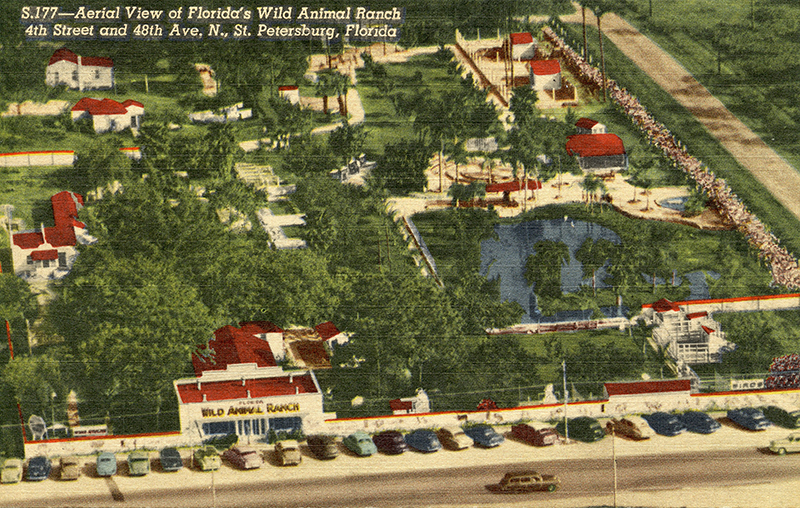In the decade after the Great War, St. Pete boomed. The city’s full-time population multiplied with nearly 12 new residents arriving every day. Building permits skyrocketed. The city borders expanded. New and improved roadways and bridges crisscrossed the peninsula and beyond. The November 1924 bridging of the bay that connected St. Pete to mainland Florida and the rest of the country was publicized around the globe. By December 1925, national newspapers including the New York Times had advertising that featured the ease of accessing the “wonderful winter playground” of the “sunny Pinellas Peninsula” via the Gandy Bridge. New hotels and entertainment venues were already on the rise, and the Gandy Bridge opened up a whole new area for development and a wider potential target audience. For the next 30 years, the Fourth Street corridor would be virtually unchallenged in its response to the needs and wants of this growing market.
“The longest motel street in the world”
As car ownership for average Americans expanded and driving vacations became increasingly common, so did the need for lodging. Fourth Street development met this need with enthusiasm. Dominated by the emergence of “mom and pop”-managed motels (motor-hotels), these Fourth Street motor-lodge venues were meant to cater to vacationers on wheels. Billboards placed as far away as Chattanooga, Tenn., directed travelers south to St. Petersburg’s Fourth Street. Jim Crow segregation still dominated in the South. For white vacationers, the smaller, less expensive, and family-friendly motels offered a perfect alternative to the fancier downtown or golf-course adjacent hotels. By the mid-1950s, Fourth Street was being celebrated as a “3,000 room palace” and the “longest motel street in the world.” From La Mar Motel at 88th Avenue N to Banyan Tree Motel at Sixth Avenue North, more than 100 motels vied to attract tourist dollars. Neon signs brightly displayed their Florida holiday-themed names (from the Azalea Court and Orange Motel to the Sunset Villa and Suntan Motel) and touted their low rates, (optional) air conditioning, and efficiencies. Popular postcard advertisements showed off motel pools and spacious parking lots while also emphasizing their proximity to Fourth Street’s numerous restaurants and popular attractions. From nearby Derby Lane to Sunken Gardens, Fourth Street had it all, including the wonders of the Earl Gresh Wood Parade and Florida Wild Animal & Reptile Ranch.
Earl Gresh Wood Parade: “the most worthwhile attraction”

Most recently the site of the Melting Pot restaurant, the building Earl Gresh constructed in the early 1930s was both a showcase of his work and a showplace for additional wood creations. As an early brochure notes, “The architecture of Kent, England was chosen … because it offers the best opportunity for displaying the work of wood craftsmen.” Opening in January 1940, the Wood Parade was a nationally acclaimed workshop, gift shop, and museum. People came from all over to pay 25 cents to view and, it was hoped, to purchase, Gresh’s wooden wonders, which included fishing lures, tackle boxes, purses, and jewelry as well as to admire other carved pieces from around the world. In particular, they marveled over the museum’s centerpiece, a 3-ton, 11-foot-wide cross-section of an ancient cypress tree in which Gresh had carved historical figures from across the centuries and inserted them into the tree-ring timeline. They also came to view Gresh’s hand-carved “paintings in wood” depicting the life of Christ in more than a dozen separate scenes. This “most worthwhile attraction” was a mainstay on Fourth Street until transportation innovations and rerouted traffic led Gresh to close its doors and auction off its contents in 1958.
Florida Wild Animal & Reptile Ranch: “bring your camera”

For 21 years, the Florida Wild Animal & Reptile Ranch was one of the largest and most diverse animal menageries in Florida as well as the home of a lucrative side business manufacturing and selling snake- and alligator-skin products. Opened in December 1938 by former circus roustabout and animal wrangler Sterling William Thomson, this landscaped, seven-acre zoo was a tourist favorite. The ranch’s brochures excitedly invited guests to “bring your camera” and “COME AND SEE WHY EVERYBODY SAYS IT’S THE GREATEST ATTRACTION OF FLORIDA’S WEST COAST!” Assisted by other former circus performers, including Thomson’s wife, Joan Spalding, a former trapeze artist and aerialist, the ranch showcased an 850-pound Russian Brown Bear as well as giraffes, kangaroos, ostriches, porcupines, alligators, crocodiles, zebras, camels, snakes, and Florida Panthers. It even had an elephant named Indi. In the 1940s, long before much thought was given to animal rights, the ranch took two infant chimpanzees from their mother and brought them home to star in its animal “shows.” In the 1950s, the ranch added a grandstand stage and expanded its collection with exotic birds and aged-out circus animals. In 1959, as traffic and business moved beyond the Fourth Street corridor, the animals were sold, and the ranch also closed its doors for good.

An Era Ends
Ironically, expanded transportation connections gave birth to Fabulous Fourth Street’s success. Expanded connections also contributed to its diminishment, as the advent of the Sunshine Skyway Bridge, U.S. 19, and the Howard Frankland Bridge rerouted traffic and business away from Fourth Street. Today, Fourth Street has rebounded as an economic corridor, but only Sunken Gardens and a handful of the 100-plus motels remain to remind us of those early decades when visitors could follow the neon lights down Fourth Street’s version of Florida’s “wonderful winter playground.”
Source available on request. Special thanks to the previous research by St. Pete Catalyst and Preserve the ‘Burg.



